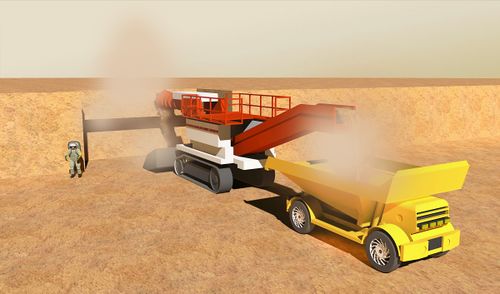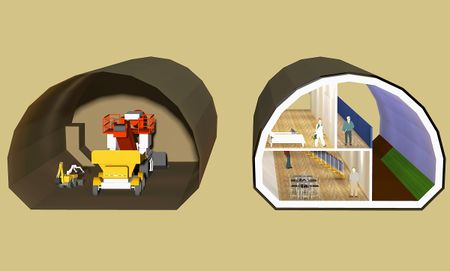Difference between revisions of "Mining"
| Line 1: | Line 1: | ||
| + | [[File:Mine tile.JPG|right|frameless|61x61px|link=Create a settlement]] | ||
[[File:Roadheader and truck.jpg|thumb|500x500px|A roadheader digs into a regolith cliff and feeds an automated truck.]]'''Mining''' is the process of collecting raw materials from the Martian [[natural resources]] for further processing. The raw materials extracted from the martian surface are frozen [[water]], [[minerals]] and [[ore]]. The thin [[atmosphere]] can be exploited for resources by [[Atmospheric processing|atmospheric mining]]. | [[File:Roadheader and truck.jpg|thumb|500x500px|A roadheader digs into a regolith cliff and feeds an automated truck.]]'''Mining''' is the process of collecting raw materials from the Martian [[natural resources]] for further processing. The raw materials extracted from the martian surface are frozen [[water]], [[minerals]] and [[ore]]. The thin [[atmosphere]] can be exploited for resources by [[Atmospheric processing|atmospheric mining]]. | ||
Revision as of 09:06, 2 August 2019
Mining is the process of collecting raw materials from the Martian natural resources for further processing. The raw materials extracted from the martian surface are frozen water, minerals and ore. The thin atmosphere can be exploited for resources by atmospheric mining.
Contents
Technology
Mining is an energy consuming activity. Due to the hostile environment, the digging machines are expected to be automated, or be remote controlled. However, in-situ resources are almost always less expensive than resources imported from Earth.
Surface Mining Methods
Strip Mining
When resources are available close to the surface, a strip mine is the most efficient method of extraction. The layers of regolith covering the resource are taken away, and the exposed ore is mined. This method is also called open-pit mining, or regolith harvesting, depending on the depth of the work.
Subsurface Mining Methods
When the natural resource lies far underground, it is more efficient to dig tunnels to access the ore than to remove the overlaying rock and regolith. Since Mars has only about 38% as much gravity as Earth[1] people should be able to extend mines to a depth about 2.6 times as deep as on Earth without the tunnel collapsing from hydrostatic pressure. This should allow the search for valuable minerals to a depth of more than seven kilometers. There are many subsurface mining methods, and they are often used in conjunction with each other.
Drift Mines
Drift mining consists of primarily horizontal tunnels. These are most often dug into a hillside.
Slope Mining
Slope mining uses diagonal tunnels to access ore.
Shaft Mining
Vertical shafts are used in shaft mining. The shaft is often provide with an elevator system and used to access extended horizontal galleries.
Room and Pillar Mining
In this method, large galleries are dug into the ore. Pillars of ore are left at regular intervals to support the ceiling. After all the ore has been removed, these pillars may be removed through retreat mining, leading to the collapse of the chamber. This collapse may lead to surface subsidence.
Longwall Mining
Longwall mining begins with a long horizontal shaft. The roof is held up mechanically by moveable supports. One side of the shaft is mined along its entire length. As this mine progresses, the mechanical supports move forward with the face. The old area of the mine is left unsupported, and allowed to collapse under its own weight, often leading to surface subsidence.
Secondary use for mining galleries
The artificial caves created by mining can be a valuable side effect of subsurface mining. They can be used to expand the settlement with storage rooms, living rooms, underground greenhouses, gas container for energy storage or for storage of chemicals.
See also
Reference
- ↑ McGRAW-HILL ENCYCLOPEDIA OF Science & Technology, 8 th edition, vol. 10 (c) 1997 page 527









